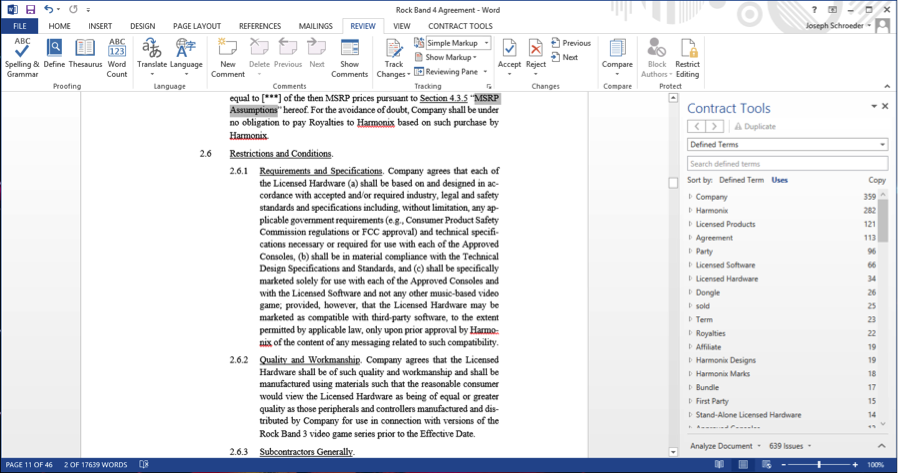 As any corporate lawyer knows all too well, drafting and editing lengthy contracts is a time-consuming, painstaking process. Millions of hours have been spent by junior associates who have stayed up into the wee hours of the morning to ensure that defined terms are used properly and that every cross-reference is in its rightful place. Contract review has been a rite of passage for new associates, and is largely a feat of manual labor.
As any corporate lawyer knows all too well, drafting and editing lengthy contracts is a time-consuming, painstaking process. Millions of hours have been spent by junior associates who have stayed up into the wee hours of the morning to ensure that defined terms are used properly and that every cross-reference is in its rightful place. Contract review has been a rite of passage for new associates, and is largely a feat of manual labor.
Until now, that is. The folks at Paper Software have come up with an incredibly useful product called Contract Tools that will help to alleviate some of the most painful aspects of contract drafting. Functioning as a simple add-in to Microsoft Word, Contract Tools creates a superior platform for contract drafting and review in software you’re likely already using. The best part is, it actually works.
A trial run of Contract Tools was enough to show that the software has real potential to drastically reduce the time it takes to turn a draft contract into a final product.

[E-BOOK] 5 AI Productivity Hacks To Save Time And Streamline Your Law Firm
Discover five practical ways to harness AI and eliminate busywork—so you can focus more on your clients and less on repetitive tasks.
Review and Analysis
Navigating through a contract with Contract Tools is a highly intuitive process. The software analyzes the document and presents its provisions in a simple outline format, allowing you to jump to any part of the contract with just a click, and eliminating the need for endless scrolling or term searching.
This easy presentation isn’t limited to standard contract headings. Contract Tools pulls up lists of other items that appear frequently in your document, such as defined terms or cross-references, and it does so automatically. You can also limit the analysis to specific portions of a document.
By simply clicking on “Defined Terms,” you can easily view every instance in which they appear. You can also jump between defined terms, which is something you can’t do with traditional search functions, where you’re limited to reviewing one term at a time.

Skills That Set Firms Apart
Legal expertise alone isn’t enough. Today’s most successful firms invest in developing the skills that drive collaboration, leadership, and business growth. Our on-demand, customizable training modules deliver practical, high-impact learning for attorneys and staff—when and where they need it.

Contract Tools is capable of analyzing a contract in just seconds, generating lists of provisions, defined terms, cross-references, and other items at lightning-fast speeds. It takes less than a second to process a 30-page contract, about two seconds for an 80-page contract, and about three seconds for a 150-page contract. Even the most diligent associate is no match for those speeds. In a legal market where there’s increased pressure to cut costs, such efficiency is invaluable.
Editing
In addition to generating convenient outlines and lists, Contract Tools makes it easy to navigate through and edit a contract without ever looking away from your document. For example, if you’re reviewing a contract and come across a cross-reference that seems odd or a defined term that you don’t recognize, reviewing the referenced item is easy. By simply double-clicking the cross-reference or defined term, you’re taken directly to the referenced provision or the place where the term is first defined. After you’re done reviewing the item, you can continue where you were reading with the help of handy back and forward buttons that allow you to go right back to where you left off.
Contract Tools also makes editing contracts easier by incorporating a useful defined term autocompletion feature. Just type the first few letters of a defined term into the document, and the software will provide a list of defined terms to choose from. Select the appropriate one, and you’re good to go.
Another neat feature for editing contracts is Contract Tools’ ability to identify “To-Dos”, such as blanks and bracketed text. When you think you’re done editing your contract, this function also serves as a check to make sure you really are. Now you’ll never have to worry that you forgot to go back and complete something.
Cross-Referencing
Ensuring the consistency of cross-references is one of the most crucial tasks in contract drafting. It’s also one of the most frustrating and time-consuming. With traditional Microsoft Word functionality, you’re limited to running searches for individual contract provision numbers to see where references to those provisions appear. For a 150-page contract, this typically involves hundreds of tedious searches.
Contract Tools automatically does this work for you. Without having to execute a separate search, part of the software’s initial analysis of your document is to generate a handy list of cross-references, showing you every instance where a given provision number is referenced in your contract. No additional searches need to be run, and you can simply click your way through the list until you’ve reviewed them all.

The useful navigation screen is set up so that your list is displayed next to the text of your document, meaning you’ll never have to switch back and forth between screens or worry about losing your place. It’s never been easier to check for internal consistency in a document.
Issue Spotting
Perhaps the single most useful feature of Contract Tools is its ability to spot potential problems in your document. Again reviewing for internal consistency at speeds that attorneys could never hope to match, the “Issues” function will save you hours of review and proofreading.
Automatically generated at the bottom of your screen, Contract Tools highlights every instance of a potential problem in your document:

These are not just typical spelling or grammar errors, but issues specifically relevant to the internal consistency of contracts. Contract Tools calls out:
- Unused Defined Terms – instances where you’ve defined a term, but then never used it again;
- Defined Terms Used Once – instances where a term is used only once after being defined;
- Unknown Cross-References – internal references in your document that might not make sense;
- Capitalized Phrases Not Defined – instances in which you perhaps should have defined a term, but didn’t;
- Duplicated Defined Terms – terms that were unnecessarily defined more than once;
- Miscapitalized Defined Terms – ensures consistency in your use of defined terms;
- Formatting Error – identifies internal inconsistencies in document formatting;
- List Order Error – notifies you if your numbered provisions aren’t in order, or if a list of defined terms isn’t in alphabetical order;
- Unmatched Punctuation Error – highlights when an opening parenthesis lacks a closing parenthesis (and vice versa).
The software also conveniently allows you to define and tweak the parameters of what is recognized as a defined term, thereby tailoring the analysis to your specific document.
Searching
Contract Tools provides some unique features that supplement Microsoft Word’s find and replace functions in a way specifically designed for contract drafting.
Beyond the handy “Issues” function discussed above, Contract Tools employs a “Tokens” function that searches for common items like dates, numbers, monetary amounts, and the like.
For instance, if you add a date token, the software will highlight every instance in which a date is referenced in your document. Adding a money token will call out every instance in which a monetary figure is mentioned.

With these lists, you can easily identify important features of the deal, such as deadlines or payments—the kinds of things that change frequently during contract negotiations, but are of utmost importance to the client.
And, because Contract Tools operates within Microsoft Word, you can still run your traditional spell check without changing screens or opening additional programs.
In fact, Contract Tools’ functionality as an add-in to Microsoft Word rather than as stand-alone software is what makes it such an obvious choice. The software adds invaluable drafting and editing tools to your arsenal, in the software you’re already using.
Let’s be honest—when you’re dealing with documents into the hundreds of pages, you’re bound to make mistakes. And when it comes to contracts, any kind of mistake can be costly for your client down the road. A tool that identifies potential mistakes from the start is a tool that you need.
While human error is inevitable, with Contract Tools there’s much less of an excuse for producing an agreement that isn’t in perfect shape.
With the countless costly hours that will be saved and the dramatic increase you’ll see in the quality of your documents, there’s no reason not to install Contract Tools today.